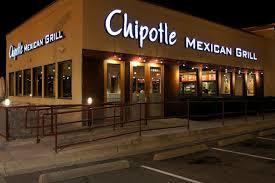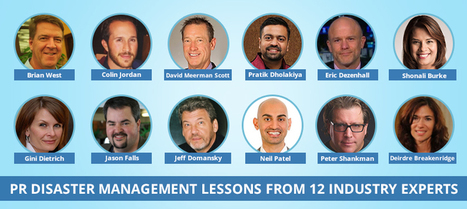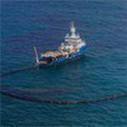 Your new post is loading...
 Your new post is loading...
What's a little e coli among friends? That's the question US fast-casual dining chain Chipotle will soon be asking its best customers. After publicly eschewing the idea of launching a customer loyalty programme last year, Chipotle executives said on an earnings call last week that they aim to stem the flood of frequent diners abandoning the chain with - wait for it - a loyalty programme. Though the programme is likely to be temporary, Chipotle hopes it will reignite customer passion for bowls and burritos. The problem: Chipotle executives still seem to display a fundamental misunderstanding of the purpose of loyalty programmes.
The announcement was one of the only positives in an earnings call that can only be described as apocalyptic: same store sales fell nearly 30% in the first quarter of 2016 and the company posted a net loss of $26.4 million. The company has tried everything to pull out of the free fall: giving away millions of free burritos, BOGO offers, national advertising campaigns; nothing has worked. Money quote from reporter Virginia Chamlee over at eater.com:
"The aim is to target the most loyal Chipotle consumer — i.e. the one who visits 25 or more times per year. The company saw the largest declines among its top loyal (25+ visits a year) and its 'light' consumers (those that visit two to five times per year). Noting the decline in visits amongst its once most-loyal customers, [Chief Marketing and Development Officer Mark] Crumpacker said the company would love to get that 'habit' back up. "We do believe it's beneficial to us to get people back in the habit of visiting Chipotle [as often as they used to]."...
Gawker recently turned food marketers' heads with a 2,500-word takedown of blogger, dietary guru and anti-GMO activist Vani Hari, aka "Food Babe." Author Yvette d'Entremont, who started a rival blog under the "Science Babe" moniker, asserted that Hari peddles easily disproved pseudoscience designed to frighten people into emptying their pantries of "toxins" and send angry emails to major food conglomerates.
Vani, a New York Times bestselling writer and TV talk show guest, responded with a can't-we-just-be-friends lament before casting d'Entremont as a "biased," pro-pesticide advocate promoting that most unpopular of agricultural villains—Monsanto. She even created a disclaimer for readers who visit her site from links in the Gawker post: "Coming from Gawker? Warning: I believe you should have both sides of the story before you make an informed opinion. Read the other side of the story here."
A larger trend is lurking beneath this spat over digital influence: America is facing a growing crisis of credibility in food labeling. And as consumers struggle to decide whom to trust—passionate bloggers or major food brands—agencies can get caught in the crossfire....
Ketchum’s staff members who provide public relations advice to Russia must avoid being seen as defending acts contrary to American interests while still providing some luster for a lucrative client.
In 2006, executives from the public relations firm Ketchum flew to Moscow to secure an account that has since been worth tens of millions of dollars.
President Vladimir V. Putin of Russia had hired Ketchum to provide advice on public relations before the nation hosted the Group of 8 meeting in St. Petersburg. At the time, Mr. Putin “cared a great deal about what other leaders, especially presidents, thought about him,” said Michael A. McFaul, a former United States ambassador to Russia who now teaches at Stanford.
Times have changed. The escalating conflict between Russia and Ukraine has turned relations with the United States as frosty as they have been in years. Last week, President Obama said that as a result of the economic sanctions imposed on Russia, the country “is already more isolated than at any time since the Cold War.” And the United States ambassador to the United Nations called Russia’s actions in Ukraine a “threat to all of our peace and security.”
When Common Ground PR announced Monday that it would be providing “short-term assistance” to the city of Ferguson, Missouri, online sleuths quickly began looking into the firm.
Clashes between the mostly white police force and people protesting the police shooting death of 18-year-old Michael Brown, an African-American man, have had a racial charge to them. That led Talking Points Memo and others to question why the city had hired a PR firm that appears to have no black people working in it.
Wednesday afternoon, the president and CEO of Common Ground, Denise Bentele, issued a statement addressing those concerns and answering why the firm stepped up....
You may very well ask how–after the initial broadcast of fake names of Asiana pilots by KTVU after the San Francisco crash and the subsequent revelation that they were confirmed to KTVU by the summer intern for the National Transportation Safety board–things could possibly get worse for KTVU. Well, now KTVU has triggered what is now commonly referred to as the “Streisand effect” in its attempt to scrub all of the videos of their on-air blunder from YouTube. The stealth move has worked like a charm, except for all the reports about it, which basically makes them just about as stealthy as Inspector Clouseau....
Fans had made a to-be-published book by Paula Deen a top seller on Amazon, but the publisher, Random House, joined the list of business partners that have cut ties to the embattled chef....
The book deal was one of the last remaining lucrative business relationships for the embattled celebrity chef. Its cancellation came on a day when Sears, Kmart and J. C. Penney announced that they would stop selling products, including cookbooks, branded with her name. Since last week, the Food Network, Smithfield Foods, Walmart, Target, Caesars Entertainment, QVC and the pharmaceutical company Novo Nordisk have decided to suspend or sever ties with Ms. Deen after her admission in a legal deposition that she had used racist language in the past and allowed racist, sexist, homophobic and anti-Semitic jokes in one of her restaurants. Ms. Deen was deposed on video as part of a discrimination lawsuit filed last year by a former employee....(New York Times)
Food Network, Walmart, Caesars Entertainment…one by one, the many companies represented by Paula Deen are backing out on deals they’ve forged with the celebrity chef. The latest business to wash its hands of Paula Deen? Pharmaceutical company Novo Nordisk.
The bad news continues for fallen idol Paula Deen, who, following allegations of racism, has been losing valuable deals left and right. Whether or not company leaders feel that Paula is actually a racist, they clearly do not wish to be associated with all the bad PR following this case.
In the Twitter era, marketers have to be extra careful that what they put on their websites isn't offensive, even intentionally. Extra, extra careful. It’s a lesson Target took to heart this week, apologizing for a product-naming discrepancy that some fuller-figured shoppers found offensive. The kerfuffle started when self-described “Digital Maven” Susan Clemens was shopping on Target.com and noticed an odd thing: The same style of dress in the exact same color was labeled differently depending on the size. The name of the color on the plus-size version was suggestive, and not in a flattering way. Clemens tweeted her discovery, quickly garnering dozens of retweets....
A lot of discussion and PR thought leadership have been focused on managing crises in this age immediate communications and networked audiences. However, a fascinating situation that’s unfolding right now between the New York Timesand Tesla Motors highlights the important opportunity brands have to tell their side of the story immediately and convincingly when they have a dispute with the news coverage, and it sure beats the daylights out of having a correction or clarification printed three days after the fact. Simply put, brands don’t have to take what they consider to be unfair or biased coverage lying down....
The way we see it, the three biggest potential PR fails for a social network are service dropouts,unannounced changes in service conditions or privacy breaches. Flickr, the extremely popular photo sharing service owned by Yahoo that is not in any way threatened by the rise of Instagram, is now dealing with every social company’s PR nightmare: due to a software bug, the company unintentionally celebrated its ninth birthday by making thousands of users’ private photos publicly visible for nearly three weeks (while they didn’t appear in Google searches, they were visible to all other users)....
...this case will continue to raise further discussion and awareness about the power of a reputation as well as the implications of what happens when you are involved in a crisis. Social media will continue to be a platform where people come together to voice their opinions about a variety of topics ranging from brands to people. This is a growing issue in sports – as fans and the rest of the public, we want athletes to achieve impossible expectations in their sports while also presenting themselves in a positive image among their key audiences. However, are these expectations not realistic and can any athlete meet up to them? What about the role of the PR person who is representing these clients – if we know that the image if false, what is our professional and ethical duty?...
After more than a decade of vehement denials, Lance Armstrong finally came clean last night in an interview with Oprah Winfrey about his use of performance enhancing drugs. Early reviews leaned negative: Forbes said "Lance Armstrong admitted a lot of wrongdoing during his 90-minute interview with Oprah Winfrey tonight, but he did almost nothing to win back the sympathy of the world." CNN host Piers Morgan took it one step further, posting on Twitter that Armstrong was a "sniveling, lying, cheating little wretch...I hope he now just disappears." Armstrong's recent tribulations have been of particular interest to me for two reasons: first, because of my past work as a presidential campaign spokesperson, where fighting off rumors and mitigating media crises is a daily part of one's job; and second, because in 2004, when Lance mania was at its peak and half the world was wearing yellow Livestrong bracelets, I became the executive director of the Massachusetts Bicycle Coalition. In the world of bicycle advocacy, Armstrong (whom I met once) was almost a saint: the talent of Michael Jordan, the charitable commitment of Angelina Jolie, plus a dash of come-from-behind, survivor heroism....
The term “content marketing” has become so ubiquitous that its radical nature sometimes gets muted, but it has transformed traditional notions of public relations. Content-hungry audiences are less interested in the source of content as they are in the quality and utility of the content, and brands must now arm themselves with a deep well of material to fuel their social media efforts.
Eliza Anderson, global PR manager of Intrepid Travel, and a speaker at PR News’ Feb. 27 Digital PR Summit in San Francisco, is a seasoned pro at creating content for the brand's customers and the media. Just a month ago her team launched a blog to provide updates to Intrepid Travel passengers about the situation on the ground during the Bangkok riots, which was then picked up by the media.
In the following Q&A, Anderson, who leads communications at the adventure travel company headquartered in Melbourne, Australia, discusses her content strategy and offers a preview of her presentation at the Digital PR Summit. ...
|
No matter how well you prepare, sometimes things just go out of your control. It is not always possible to prevent a crisis. When it comes to PR campaigns, learning from your mistakes can be too costly. The trick should therefore be learning from other people’s mistakes.
According to the First Research study, the U.S. public relation industry is estimated to be at $10 billion, with above 7,000 U.S. firms in action in 2013. Still a large number of businesses suffer the adverse effects of PR disasters. Why is it so? Let’s take a take look at the factors that lead to PR disasters
So how important is it to make sure that your corporate website – and therefore your crisis communications home base – is mobile-friendly? Pretty important.
And I’m not the only one who thinks so, Google thinks so as well.
Google has actually started to penalize websites that don’t provide mobile users with a mobile-friendly experience. This means that, in (and out of) a crisis, if your website is not mobile-friendly, not only are you making it harder for your stakeholders to navigate through your site and easily read your communications, but Google may be penalizing your website’s search engine rankings....
Last week, an audio technician for the television program Cops was killed by friendly fire while filming a robbery at a Wendy’s in Omaha, Nebraska.
The Omaha police chief, Todd Schmaderer, delivered an almost perfect press conference—one that stands in marked contrast to the shameful media interactions in Ferguson, Missouri—that should be studied by PR professionals as a terrific example of how to communicate in crisis.
PR pro Dave Statter, who writes the excellent STATter911 blog (and wrote about this story first), called this “one of the most effective and timely presentations following a police involved shooting I’ve witnessed.”
He’s right. Chief Schmaderer did many things right in this press conference. Below, you’ll find the five things that stood out to me most....
Chances are, sooner or later you will find yourself caught in a social media wildfire, or at least see smoke in the distance. Are you prepared to fight the fire? I asked seven of the leading social media crisis experts, “what is the most important weapon you need to fight a social media crisis?” With their answers, you can build a full arsenal to manage any negative event you face....
Here are 5 benefits of using a mobile app for your internal crisis communications - and which industries and types of organizations would best benefit.
Intranets are a great tool for large organizations that have offices all around the country and the world, but what about when you have workers on the ground? Workers on the ground don’t necessarily have a computer in front of them at all times, but what they definitely do have is a mobile phone. Creating an app designed specifically for your internal (crisis) communications will allow you to:- Access and reach each and every member of your team, no matter where they are at any given time – and all at once...
Happy, Friday. This week's Friday PR Picks and social media missives are loaded with crisis management, content marketing and communication insight.
We're featuring 9 valuable crisis management, 10 public relations posts and 14 must-read social media articles. Perfect for the long weekend.
The arrest of the animal hospital’s former employee for bestiality horrified the public, but Peak Communicators disassociated the clinic from the accused—and pushed a positive story instead.
Crisis management has changed significantly. If you are a corporate leader of a multinational company today, and aim to protect your reputation for the long term, you need to ask yourself two questions: are we ready and are we nimble? Are we properly organized and can we respond in time when faced with a crisis? If you still rely on manuals that are more than six months old and do not have social media at its core, both questions are answered. Millions of citizen journalists roam society every day, with phone cameras and Internet access at the ready. They capture and instantly transmit around the world what they witness-or think they witness. They pass along unverified "news flashes" from acquaintances. Their tweets and posts become stories, alongside news from more established sources. These reports, unregulated and uncorroborated as they are, can create irreversible damage when inaccurate and left unaddressed....
...The Times pretty much disagreesin every respect. They stand by their story which said that the vehicle did not meet its own promises and that the battery failed, requiring the Model S make the last part of its journey on a flatbed truck.
It is not just "he said" vs "she said" however since Tesla published data captured by their onboard computer which seemed to back up some of what they claim....
The star Notre Dame football player enmeshed in a scandal over his apparent relationship with a fictional woman has engaged crisis specialist Hiltzik Strategies.
The Notre Dame linebacker, Manti Te’o, fell into the media crosshairslast week after Deadspin.com published a thorough examination of Te’o’s relationship with a woman -- widely reported as an inspirational story because of her battles with cancer and death in a car accident -- it found did not exist.
He has denied knowledge that the woman and story were fabricated through social media. Notre Dame’s influential athletic department has backed his denials.
Hiltzik Strategies, the firm of former Democratic political operative Matthew Hiltzik, has worked crises for high-profile personalities like Katie Couric, baseball star Ryan Braun and singer Justin Bieber. He is representing Te'o and his family....
This was the week of not quite apologizing enough. Lance Armstrong appeared on the Oprah Winfrey Network to explain 20 years of cheating, lying and cruel personal destruction of his truthful critics. He repeatedly said he was sorry for his conduct, but left the distinct impression that he was sorry mainly for getting caught. And his claim that he did not force his teammates into doping, among other continued denials, sounds like a crock. Notre Dame linebacker Manti Te'o named the supposed hoaxer who created the fake Lennay Kekua persona who e-romanced the football star before tragically dying, and even before actually living. Te'o's story can be proved or disapproved in about 5 minutes with a peek at his cell phone records, yet university officials have not been curious enough to look at them. Nor did they refute two years of false stories about the star-crossed lovers until at least a week after learning of the hoax. Yet the most shocking non-apology apology was buried in the avalanche of coverage about the disgraced athletes. The true disgrace belongs to Atlantic President M. Scott Havens, whose memo to colleagues about the magazine's ill-conceived online advertorial from the Church of Scientology fails just about every test of honesty, judgment and simple common sense.
Read more: http://www.mediapost.com/publications/article/191476/the-truthiness-is-out-there.html#ixzz2IdlSIVT4
Through PR, all things are possible. Maybe. Lance Armstrong's career as a public figure, it would seem, is over. After all, he did not one but several of the lowest things you can do in sports (and life, really): He cheated, he lied about cheating, he allegedly harassed and persecuted those who told the truth about his cheating—and worst of all, he became an international hero in the process. Now that the U.S. Anti-Doping Agency has found Armstrong on the wrong end of "conclusive and undeniable proof" of a decade's worth of performance-enhancing drugs, and he's been banned from cycling for life and stripped of his seven cherished Tour de France titles, the public's regard for Armstrong has tumbled from Superman status down to the depths of disappointment and scorn. But if disgraced heroes like Barry Bonds, Mark McGwire, Martha Stewart, and Tiger Woods taught us anything, it's that there's always a way to crawl back into the public's good graces—with the help of some powerful image-rehab magic conjured up by a trained professional, that is. What, if anything, can be done to help rebuild Armstrong's image? Lance Armstrong, after all, isn't just a man. He's a marketable brand, too. Since it launched in 1997, his foundation Livestrong (formerly known as the Lance Armstrong Foundation) has raised more than $470 million for cancer awareness and research. So I asked four professionals in brand management, public relations, and consulting what advice they would give to Armstrong to help salvage what's left of Brand Lance...
|




 Your new post is loading...
Your new post is loading...



![[US] PR Firm for Putin’s Russia Now Walking a Fine Line | NY Times | Public Relations & Social Marketing Insight | Scoop.it](https://img.scoop.it/gIca6UV63vQonzUzWhv_ETl72eJkfbmt4t8yenImKBVvK0kTmF0xjctABnaLJIm9)































Will a new loyalty program bring customers back to Chipotle after the E. coli crisis?